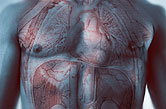 |
 |
 |

Genetic Cause of Statin-Related Muscle Pain Found
British researchers identify variant that increases risk of myopathy at high doses|
|
HealthDay
Wednesday, July 23, 2008
 WEDNESDAY, July 23 (HealthDay News) -- British researchers have discovered a genetic variant that causes some people who take cholesterol-lowering statins to have the muscle weakness called myopathy.
WEDNESDAY, July 23 (HealthDay News) -- British researchers have discovered a genetic variant that causes some people who take cholesterol-lowering statins to have the muscle weakness called myopathy.
"We found a variant that affects the transport of statins into the liver," said Dr. Rory Collins, a professor of medicine and epidemiology at the University of Oxford and a leader of the group reporting the discovery in the July 24 online issue of the New England Journal of Medicine. "That variant produces a high level of blood statins and accounts for the greatest proportion of myopathy in people who use statins."
That side effect is not common, although it has been reported in a number of studies. It occurs in fewer than one of every 1,000 people taking statins. The new study indicates that one copy of the myopathy-related variant is carried by about a quarter of the population, Collins said, with a much smaller percentage carrying two copies. The variant accounts for about 60 percent of all statin-related myopathy cases, Collins said.
"It causes a substantial increase in relative risk," he said. "The risk is increased about fourfold for those who have one variant version of the gene, about 15-fold for someone who inherits two variant versions."
All human genes come in pairs, one from each parent.
Even when the variant version is present, the risk of myopathy depends on how big a dose of a statin is prescribed, Collins said. "For the statin doses most usually used, 20 to 40 milligrams of simvastatin, for example, the risk of myopathy is very low," he said. "Using a high dose for someone at high risk, the absolute risk of myopathy is maybe one in 1,000. With a standard dose, the risk would be about one in 10,000."
The myopathy caused by statins generally is not severe, and it disappears a day after the medication is stopped.
It might be worthwhile testing people who are prescribed high doses of statins for the variant gene, Collins said. While the genetic technology now is available in the laboratory, "a routine screening test for family physicians would have to be developed," he aid. "That would not be very complicated."
Discovery of the myopathy genetic variant is a remarkable example of the powerful tools now available for probing the human genome, said Dr. Sekar Kathiresan, director of preventive cardiology and a principal investigator at the Human Genetic Research and Cardiovascular Research Center at Massachusetts General Hospital.
"They looked across 300,000 spots across the genome and found what the prevalence of the variant was in a very small number of people -- 85 with myopathy and 90 without," Kathiresan said. "This kind of search of the entire genome for variants that put people at risk has only been possible for the last two years or so, since we have the entire sequence of the genome."
There are about 2 billion units in the human genome, "and people differ at 10 or 12 million of those 2 billion," he said.
Other genetic variants probably are responsible for some cases of statin-related myopathy, Kathiresan said, "but probably none with as strong effect as the one they found."
Using the discovery in medical practice is "an open question," he said. "About 2 percent of people carry two variant copies," Kathiresan said. "The next step is to see whether knowing who those 2 percent of the people are can avoid myopathy."
HealthDay
Copyright (c) 2008 ScoutNews, LLC. All rights reserved.
Related News:
More News on this Date
Related MedlinePlus Pages:
| Home | Health Topics | Drugs & Supplements | Encyclopedia | Dictionary | News | Directories | Other Resources | |
| Disclaimers | Copyright | Privacy | Accessibility | Quality Guidelines U.S. National Library of Medicine, 8600 Rockville Pike, Bethesda, MD 20894 National Institutes of Health | Department of Health & Human Services |
Date last updated: 24 July 2008 |




